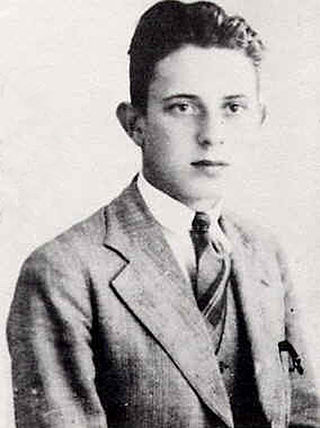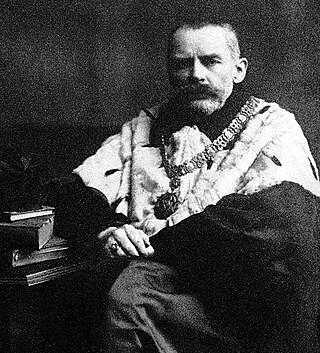Related Research Articles

Stefan Banach was a Polish mathematician who is generally considered one of the 20th century's most important and influential mathematicians. He was the founder of modern functional analysis, and an original member of the Lwów School of Mathematics. His major work was the 1932 book, Théorie des opérations linéaires, the first monograph on the general theory of functional analysis.

Wacław Franciszek Sierpiński was a Polish mathematician. He was known for contributions to set theory, number theory, theory of functions, and topology. He published over 700 papers and 50 books.

Kazimierz Kuratowski was a Polish mathematician and logician. He was one of the leading representatives of the Warsaw School of Mathematics. He worked as a professor at the University of Warsaw and at the Mathematical Institute of the Polish Academy of Sciences. Between 1946 and 1953, he served as President of the Polish Mathematical Society.

Hugo Dyonizy Steinhaus was a Polish mathematician and educator. Steinhaus obtained his PhD under David Hilbert at Göttingen University in 1911 and later became a professor at the Jan Kazimierz University in Lwów, where he helped establish what later became known as the Lwów School of Mathematics. He is credited with "discovering" mathematician Stefan Banach, with whom he gave a notable contribution to functional analysis through the Banach–Steinhaus theorem. After World War II Steinhaus played an important part in the establishment of the mathematics department at Wrocław University and in the revival of Polish mathematics from the destruction of the war.

Jerzy Witold Różycki was a Polish mathematician and cryptologist who worked at breaking German Enigma-machine ciphers before and during World War II.

Jan Łukasiewicz was a Polish logician and philosopher who is best known for Polish notation and Łukasiewicz logic. His work centred on philosophical logic, mathematical logic and history of logic. He thought innovatively about traditional propositional logic, the principle of non-contradiction and the law of excluded middle, offering one of the earliest systems of many-valued logic. Contemporary research on Aristotelian logic also builds on innovative works by Łukasiewicz, which applied methods from modern logic to the formalization of Aristotle's syllogistic.

Stanisław Leśniewski was a Polish mathematician, philosopher and logician.

Henryk Zygalski was a Polish mathematician and cryptologist who worked at breaking German Enigma-machine ciphers before and during World War II.
The Cipher Bureau was the interwar Polish General Staff's Second Department's unit charged with SIGINT and both cryptography and cryptanalysis.

The Lwów school of mathematics was a group of Polish mathematicians who worked in the interwar period in Lwów, Poland. The mathematicians often met at the famous Scottish Café to discuss mathematical problems, and published in the journal Studia Mathematica, founded in 1929. The school was renowned for its productivity and its extensive contributions to subjects such as point-set topology, set theory and functional analysis. The biographies and contributions of these mathematicians were documented in 1980 by their contemporary, Kazimierz Kuratowski in his book A Half Century of Polish Mathematics: Remembrances and Reflections.

Paulin Kazimierz Stefan Żorawski was a Polish mathematician. Żorawski's main interests were invariants of differential forms, integral invariants of Lie groups, differential geometry and fluid mechanics. His work in these disciplines was to prove important in other fields of mathematics and science, such as differential equations, geometry and physics.
The Lwów–Warsaw School was an interdisciplinary school founded by Kazimierz Twardowski in 1895 in Lemberg, Austro-Hungary.

Education has been of prime interest to Poland's rulers since the early 12th century. The catalog of the library of the Cathedral Chapter in Kraków dating from 1110 shows that Polish scholars already then had access to western European literature. In 1364, King Casimir III the Great founded the Cracow Academy, which would become one of the great universities of Europe. The Polish people have made considerable contributions in the fields of science, technology and mathematics. The list of famous scientists in Poland begins in earnest with the polymath, astronomer and mathematician Nicolaus Copernicus, who formulated the heliocentric theory and sparked the European Scientific Revolution.

Lt. Col. Jan Kowalewski was a Polish cryptologist, intelligence officer, engineer, journalist, military commander, and creator and first head of the Polish Cipher Bureau. He recruited a large staff of cryptologists who broke Soviet military codes and ciphers during the Polish-Soviet War, enabling Poland to weather the war and achieve victory in the 1920 Battle of Warsaw.

Helena Rasiowa was a Polish mathematician. She worked in the foundations of mathematics and algebraic logic.

Marian Adam Rejewski was a Polish mathematician and cryptologist who in late 1932 reconstructed the sight-unseen Nazi German military Enigma cipher machine, aided by limited documents obtained by French military intelligence. Over the next nearly seven years, Rejewski and fellow mathematician-cryptologists Jerzy Różycki and Henryk Zygalski developed and used techniques and equipment to decrypt the German machine ciphers, even as the Germans introduced modifications to their equipment and encryption procedures.
The history of philosophy in Poland parallels the evolution of philosophy in Europe in general.

Aleksander Michał Rajchman was a mathematician of the Warsaw School of Mathematics of the Interwar period. He had origins in the Lwów School of Mathematics and contributed to real analysis, probability and mathematical statistics.
Henryk Hiż was a Polish analytical philosopher specializing in linguistics, philosophy of language, logic, mathematics and ethics, active for most of his life in the United States, one of the youngest representatives of the Lwów–Warsaw school.
References
This article includes a list of references, related reading, or external links, but its sources remain unclear because it lacks inline citations .(November 2014) |
- Kazimierz Kuratowski (1980) A Half Century of Polish Mathematics: Remembrances and Reflections, Oxford, Pergamon Press, ISBN 0-08-023046-6.
- Roman Murawski (2014) The Philosophy and Mathematics of Logic in the 1920s and 1930s in Poland, Maria Kantor translator, Birkhäuser ISBN 978-3-0348-0830-9